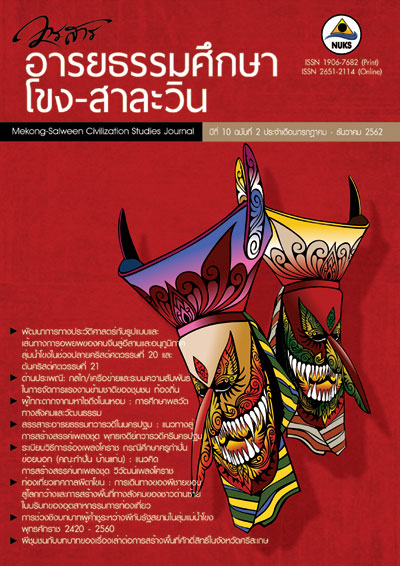ข้อตกลง
1. บทความทุกบทความจะได้รับการพิจารณาจากผู้ทรงคุณวุฒิ (Peer review) ที่ตรงตามสาขาวิชา โดยทุกบทความจะต้องผ่านการพิจารณาจากผู้ทรงคุณวุฒิ อย่างน้อยบทความละ 3 ท่าน
2. บทความ ข้อความ ภาพประกอบ และตารางใด ๆ ที่ตีพิมพ์ในวารสารอารยธรรมศึกษา โขง-สาละวิน เป็นความคิดเห็นส่วนตัวของผู้เขียน กองบรรณาธิการไม่จำเป็นต้องเห็นด้วยเสมอไป และไม่ใช่ความรับผิดชอบของ กองส่งเสริมศิลปวัฒนธรรม มหาวิทยาลัยนเรศวร ถือเป็นความรับผิดชอบของผู้เขียนแต่เพียงผู้เดียว
3. บทความจะต้องไม่เคยตีพิมพ์เผยแพร่ที่ใดมาก่อน และไม่อยู่ระหว่างการพิจารณาของวารสารฉบับอื่น หากตรวจสอบพบว่ามีการตีพิมพ์ซ้ำซ้อน ถือเป็นความรับผิดชอบของผู้เขียนแต่เพียงผู้เดียว
4. บทความที่ส่งถึงกองบรรณาธิการ ขอสงวนสิทธิ์จะไม่ส่งคืน
Selected Essence of the Dvarvati Civilization in Nakhon Pathom: A Guide to the Creation of the Buddha Chedi Dvaravati Sri Nakhon Pathom Suite
Selected Essence of the Dvarvati Civilization in Nakhon Pathom: A Guide to the Creation of the Buddha Chedi Dvaravati Sri Nakhon Pathom Suite
Keywords:
Dvaravati;, ethnicity;, Buddhist pagodas;, architectural;, music;Abstract
Selected Essence of the Dvarvati Civilization in Nakhon Pathom: A Guide to the Creation of the Buddha Chedi Dvaravati Sri Nakhon Pathom Suite is an article based on the research data collected for the composition of the said suite. Its objectives are to study social fundamentals data on the beliefs system, ethnicity, language, architectural styles, historical background and music relationship associated with the seven ancient Buddha Chedi (Buddhist pagodas) of Nakhon Pathom by using qualitative research methods. The research findings can be divided into three parts. Part 1: Belief system – the people of Dvaravati period were devout Theravada Buddhists; Ethnicity – the people of Dvaravati civilization were found to consist of 1) the Mon people and 2) people of different ethnic groups, mainly the Mon and Tai people; Language – they used the three languages of Pali, Sanskrit, and ancient Mon; Architectural structures – stupa and pagodas. Part 2: A study on the historical background of Dvaravati Buddhist pagodas revealed two sources of explanations for their construction – 1) the folktales of Phraya Kong Phraya Pharn; 2) they were built to contain Buddha’s relics and were the focal points of the Buddhist faith. This construction practice was originated in the 3rd Buddhist century and continued right up to the true Dvaravati period of the 11th-16th Buddhist century. The architectural structure of these Buddhist pagodas can be divided in three sections: the Bua Walai style of base was influenced by the Indian, Central Javanese, Cham and Khmer art styles; the middle section or Ruean that, which contains a chamber holding Buddha’s relics, can be a Prasat-shaped or bell-shaped pagoda with indented niches at the corners decorated with replica Prasat or Sum Choranam arches; and the top section decorated with an umbrella or Chat in the Central Javanese art style. Part 3: A study of the musical relationship in the areas associated with the seven ancient Buddhist pagodas of Nakhon Pathom. Three aspects of the research findings can be summarized as follows: 1) Dvaravati music – a study of Dvaravati musical instruments identified seven instruments in the three categories of stringed instruments, consisting of Bin Nam Tao (Gourd harp), Bin Ha Sai (5-stringed harp) and Chakhe (zither); percussion instruments consisting of Ching ( small cup-shaped cymbal), Krap Puang (castanet) and wind instruments consisting of Sang (conch shell), Khlui (flute) and Pi (oboe); 2) Dvaravati music associated with the ancient Buddhist pagodas of Nakhon Pathom – two musical instruments in two categories of musical instruments were found, namely, Bin in the stringed instrument category and Rakhang Hin (stone bells) in the percussion instrument category. Both instruments are associated with the acts of worshipping and reverence; 3) the musical culture of the areas associated with the seven ancient Buddhist pagodas of Nakhon Pathom – a study of the musical ensembles in six communities of Nakhon Pathom Province discovered ten musical ensembles in the categories of Khrueang Sai Thai, Khrueang Sai Phasom, Piphat Thai, Piphat Mon and Mahori ensembles. the said musical ensembles play two important roles in the local society and culture: 1) religious roles, and 2) social role. All three aspects of the research findings provided the researcher with an inspiration and creative imagination for the composition of the present repertoire.
Downloads
References
Aphiwatanasiri, U. Scholars of Ban Non Hom Village, Interviewed on April 13, 2017.
Chathiphot, P. (2017). The Social and Cultural dynamics of the Phu Tai Katak
Ban Non Hom. Sakon Nakhon: Sakon Nakhon Rajabhat University.
Fangsai, W. Teacher of Ban Non Hom Village, Interviewed on April 13, 2017.
Fine Arts Department. (1999). Prachum Pongsawadan Kanjanapisek Version Volum 4. Bangkok: Pimlak.
Kedthes, B. (2009). The Inherritance. Kalasin: Prasarn Publishing.
Khaipraphai, D. Villager of Ban Non Hom Village, Interviewed on April 13, 2017.
Narasaj, B. (2009). History of Isan Wisdom. Khon Kaen: Center for Research on Plurality in
the Mekong Region (CERP) Khon Kaen University.
Nathalang, S. (2014). Theory and science of criticism for Thai folk literature. Bangkok:
Chulalongkorn University.
Plianek, P. Villager of Ban Non Hom Village, Interviewed on April 13, 2017.
Plianek, S. Folk Healer of Ban Non Hom Village, Interviewed on April 13, 2017.
Plianek, J. Villager of Ban Non Hom Village, Interviewed on April 13, 2017.
Prince Damrong Rajabubhab. (2000). Tales of Archeology. Bangkok: Bannakharn.
Romrasri, J. Scholars of Ban Non Hom Village, Interviewed on April 13, 2017.
Srisontisuk, S. (2000). Impact of education on changing attitudes and values of the
community of Phu Tai Ethnic Group, Ban Non Hom Tambol Non Hom Amphoe
Mueang Sakon Nakhon Province. Khon Kaen: Khon Kaen University.
_______. (2001). The Study of the Phu Tai Ethnic Community Structure at Ban Non Hom,
Tambol Non Hom< Amphoe Muang Changwat Sakon Nakhon. Khon Kaen:
Khon Kaen University.
Thipakornwong, Chao Phraya. (1995). Pra Ratchapongsawadarn Krung Rattanakosin
Ratchakarn Ti 3, The history of Rattanakosin period in reign King Rama 3.
Bangkok: Fine Arts Department.
Uttawongsa, J. Villager of Ban Non Hom Village, Interviewed on April 13, 2017.
Verathawemas S and Thangsakul N. (2009). Phutai Vernacular Houses in Lao PDR. Khon Kaen: Center for Research on Plurality in the Mekong Region (CERP) Khon Kaen University.
______. (2016). Creative Folklore: Synthesis and theories.Bangkok: Princess Maha Chakri
Sirindhorn Anthropology Centre (Public Organisation).
Yaisingsorn, A. Storyteller of Non Hom Village, Interviewed on April 13, 2017.
Premjit, S. and Dore, T. (1996). Etienne Aymonier’s Memoir of Travel in Lao, 1895. Chiang Mai: Social Research
Institute.







